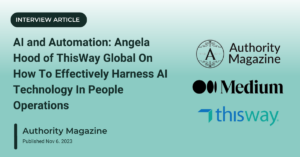If there was ever any doubt as to the importance of successful recruitment, we need only look at the current labor shortage – and the high quit rate in the workforce – that is plaguing industries across the United States. For instance, the US Chamber of Commerce estimates that there are currently over 10 million job openings in the U.S. with roughly 6 million job seekers to fill these positions.
In an effort to adapt to the changing expectations of workers and job seekers and to minimize the negative impact of trends such as The Great Resignation and quiet quitting, recruitment managers are increasingly turning to technology (more specifically machine learning) to help them improve the recruitment process and increase their chances of finding qualified candidates.

How Machine Learning Is Used in Recruitment
In a nutshell, machine learning (often used interchangeably with artificial intelligence) is the application of algorithms and analyses of big data that enables computer programs to identify patterns, draw inferences, and even make predictions.
When it comes to recruitment and candidate sourcing technology, AI-powered job search portals, similar to Lensa and ThisWay, analyze millions of resumes and job offers in real-time. Recruiters can then filter potential applicants and steer them towards job offers that best suit their backgrounds, level of experience, and particular skill sets. Additionally, these advanced search engines are able to detect patterns within career trajectories which give the job seeker insights into what qualifications they may be missing and/or what career paths they may consider embarking on that they may not have otherwise considered.
The Multiple Benefits of Machine Learning in Recruitment
The sheer volume of information AI-powered job search engines process and the speed in which they are able to do so means they end up saving recruiters a significant amount of time and resources by:
- Filtering out candidates who are under qualified for the position which they applied
- Sending out automated responses (either in the form of a rejection message or inviting the candidate to proceed to the next step in the recruitment process)
- Conducting skill assessment tests to better determine if a candidate would be a good fit for the position
In addition to saving recruiters and job seekers a considerable amount of time, machine learning also has the advantage of minimizing (if not outright eliminating) any potential recruitment bias the recruiter may have. In many instances, recruiters aren’t even aware that they have a bias since biases come in two forms, conscious and unconscious.
The Importance of Bias Elimination in Talent Acquisition
When it comes to talent acquisition, inclusion is more than a buzzword. It is an economic and business viability imperative.

A diverse workforce – meaning a workforce that consists of people from a variety of different backgrounds, ethnicities, perspectives, and outlooks–provides tremendous benefits for a company.
- When a company’s workforce more closely resembles the customer base the company is targeting, they are more likely to appeal to said customer base, increasing the chances that the targeted customer will like and identify with the company or brand.
- Recruiting from a larger talent pool greatly increases the chances of landing top talent
- A diverse workforce brings to the company different views of potential problems and different solutions to resolve or mitigate those problems
How Machine Learning Helps to Minimize Recruitment Bias
As humans, we make associations and inferences based on emotions and individual experiences. For example, a recruiter might come across the resume of a qualified applicant and see a former place of employment or a location that reminds the recruiter of their own experience–either positive or negative. This association may then influence the recruiter’s judgment of the candidate. If this influence is recognized, it is known as a conscious bias. In many instances, the recruiter is unaware of the influence and is thus betrayed by an unconscious bias.
A machine is not susceptible to this type of fallacy. The machine is given a set of directives through algorithms to make decisions based solely on those directives. For example, assuming that a candidate’s ethnicity is not part of the directive, the machine will be unable to let a candidate’s ethnicity affect its assessment of the candidate. The end result is a more accurate and fair recruitment process which is a win-win for both the company and the job seeker.
Potential Pitfalls To Be Wary Of
The AI system is only as effective as the directives it is given. It is possible that biases may be built into the directives an AI system is given – whether intentionally or not. For example, an AI-powered recruitment program may be analyzing resumes that come predominantly from male candidates, and thus the patterns it detects might not correlate with those of female candidates.
It is this concern that prompted New York legislators to pass an AI Bias Law, which will go into effect on January 1, 2023.
The Bottom Line
In today’s labor market, rife with high turnover and quiet-quitting, getting the recruitment process right is more important than ever. Machine learning is proving to be a valuable tool for recruiters in this endeavor. Not only does it save time and provide a more accurate screening process, but machine learning can help eliminate recruitment bias which should lead to more diversity and inclusion in the workplace.









